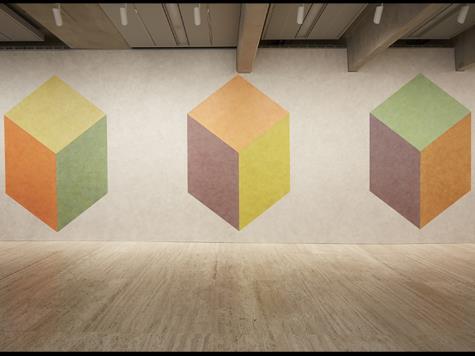Sol LeWitt, ‘Wall Drawing #604H’ (1989)
Opening recently at the Art Gallery of New South Wales, this exhibition of American artist Sol LeWitt’s work spans a 40 year period and includes four large-scale wall drawings and a number of works from LeWitt’s personal collection by Indigenous Australian artists Emily Kam Ngwarray and Gloria Tamerre Petyarre.
LeWitt is a significant figure in American modernism, pioneering Minimal and Conceptual art during the 1960s and 70s. LeWitt’s early three-dimensional forms are termed ‘structures’, with LeWitt preferring this name to the already connotation-heavy ‘sculpture’. The AGNSW exhibition includes a number of these works such as ‘Incomplete Open Cube’ (1974). As important as these works are, I cannot help but think of the influence of Minimalism on the sleek lines and clever design of contemporary mass-produced furniture such as Ikea.
A striking feature of LeWitt’s work is the strength of his concern with line, patterning, repetition and perfection. The exactness and precision of his work is one of its most important characteristics and surely something of which the assistants and technicians who have installed his large-scale wall drawings here at the art gallery are acutely aware. All the wall drawings in this show have been produced from LeWitt’s written instructions and were, even prior to his death in 2007, executed by people other than LeWitt himself.
LeWitt began showing his wall drawings in 1968 at his now famous show at Paula Cooper Gallery, NYC. During his lifetime LeWitt made plans for over 1270 wall drawings, although not all of these have ever been realised. LeWitt’s primary concern, to work with ideas and concepts, means that it is not necessarily important that all his wall drawings are actually ever made or remain on show in a gallery. LeWitt has said of his wall drawings that he wanted to create a work of art that was as two dimensional as possible, and indeed there is an extreme sense of flatness to works such as ‘Wall Drawing #604H’ (1989). LeWitt spent time in Italy in the 1970s and was influenced by the frescos of Giotto and others.
Perhaps the most beautiful wall drawing in this exhibition is ‘Wall Drawing #1274’, the last in the suite of wall drawings. This later work seems less tightly controlled, the patterning and different gradations of graphite create a horizontal line through the centre of the work. This allows the middle to recede, almost creating a horizon line, and breaking from the flatness of his other wall drawings in the show, the simplicity of this is highly appealing.
Perhaps the most exciting part of this exhibition is housed in the smaller back room along with LeWitt’s artists books and some interesting postcards sent by LeWitt to museum directors and to John Kaldor himself. This room holds the works by Emily Kam Ngwarray and Gloria Tamerre Petyarre and also many examples of LeWitt’s own tightly controlled drawings from the 1960s and 70s. The influence of the freedom of Ngwarray’s work on the control and exactness of LeWitt’s work culminates, for me, in LeWitt’s work ‘Irregular Loops’ (2001). This work in glowing yellow-gold paint marks a certain point in this artist’s late career, more broadly visible in his many explorations (from the late 1990s onwards) of what he calls ‘squiggles’ and ‘scribbles’. It is a quite startling departure from the precision and exactness of his main body of work, but still conveys his life-long interest in the exploration of line. This shift from such a high level of control, evident in his earlier work, to the freedom and abandon evident in these later works, when placed next to the freedom and gesture of Ngwarray’s work, is fascinating and uplifting.
The LeWitt works in this exhibition come primarily from the Kaldor Family and Naomi Milgrom Collections (Kaldor’s partner) with a few works also coming from the LeWitt Collection in Chester, Connecticut, USA. The close connection between this artist and John Kaldor is evident, as is the extent of the ties that have been highlighted in recent years between the Kaldor Family and the AGNSW.
Rating: 4 stars out of 5
Your mind is exactly at that lineSol LeWitt
Art Gallery of New South Wales, Art Gallery Rd, The Domain
www.artgallery.nsw.gov.au
20 February – 3 August





